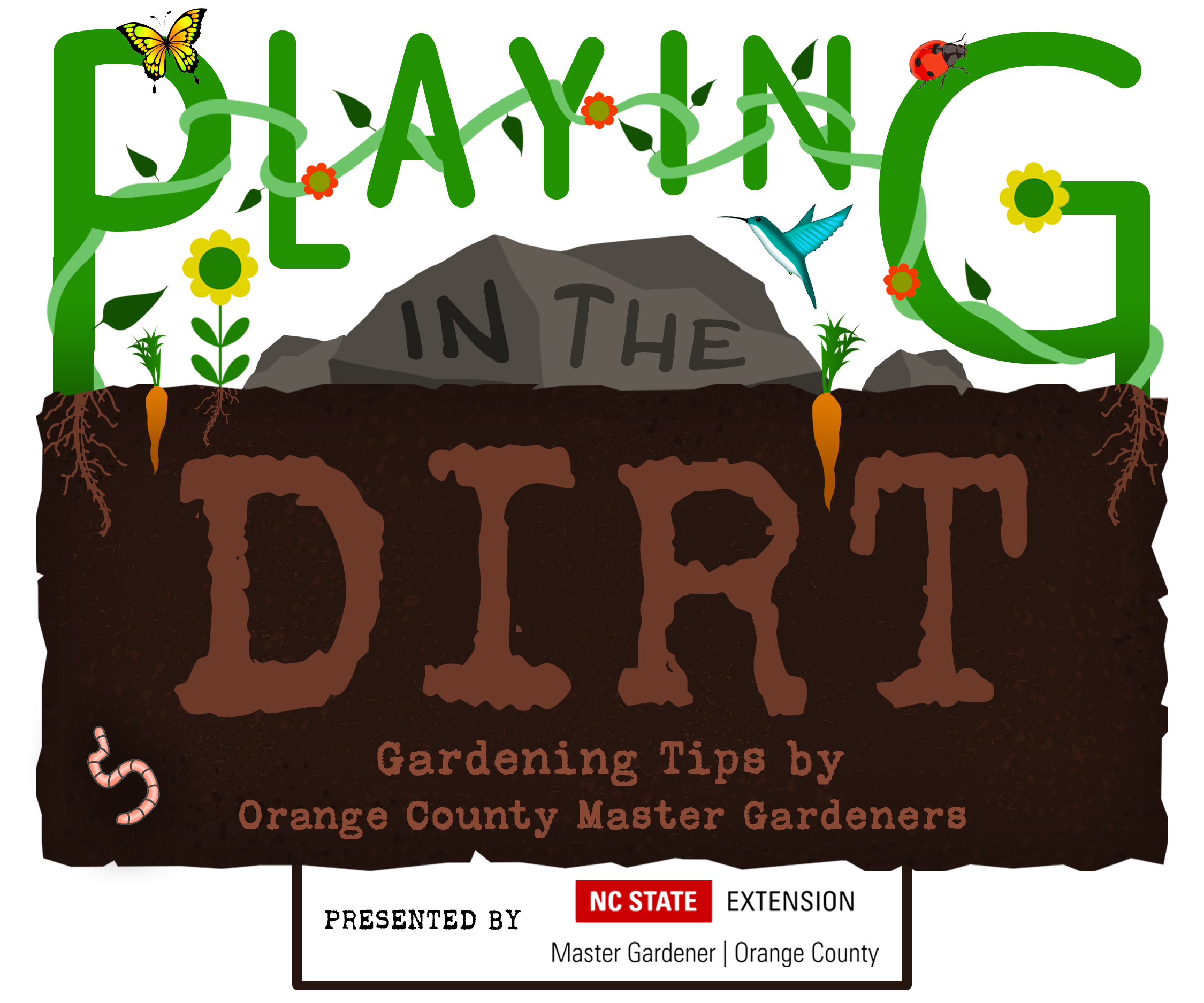
97.9 The Hill and Chapelboro.com have partnered with Orange County Master Gardeners for “Playing in the Dirt,” a monthly column exploring the fertile ground of home gardening in our community and intended to provide the information and inspiration gardeners of all skills levels need to flourish! Check back on Chapelboro each month for a new subject – from our gardens to yours!
What’s the gardener’s first step on the road to making a beautiful, lush garden on a site that doesn’t get much sun? It’s understanding and working with this limiting condition. Why? Because whether a plant lives or dies in our gardens depends on whether our site conditions can meet the needs of that particular plant. For example, most plants can’t live in deserts because of the limiting condition of too little water; and they can’t live in swamps because there’s too much water there. Successful gardeners embrace the limiting condition of lack of sunlight, and plant accordingly. Shade gardens even have an advantage in our Piedmont area of North Carolina because they tend to stay more moist during our typical hot, dry summers that stress plants. Any area with less than four to six hours of sunlight can be considered for “shade” gardening.
Following are a couple of Pro Tips from Orange County Master Gardener Volunteers Frances and Bill Harris about how to use shade-loving plants to create a shade garden like theirs, filled with shades of gr and textures.
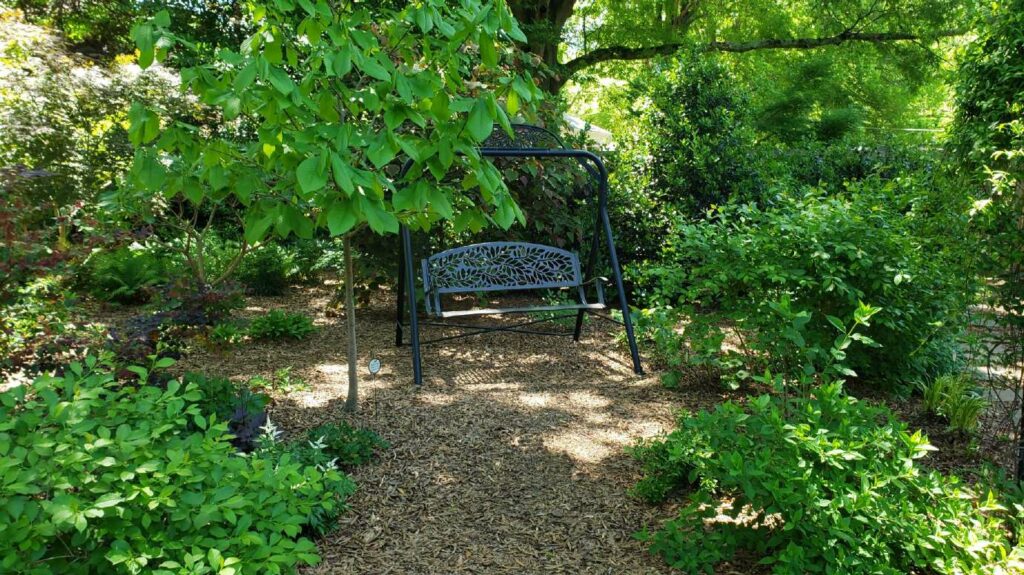
Pro Tip #1: Assess Your Site Characteristics
- Determine shade characteristics. A question to ask yourself is how much of your planting area is being shaded or otherwise impacted by trees? The amount of sunlight will limit what you can plant. For example, turf grass will not grow in dense shade. Another question is whether the soil is wet or dry? Shade generally keeps soil wet, but thirsty trees can dry out soil. If your soils are dry you will need to have watering capabilities or put in plants that can handle dry shade. You can even plant around tree roots by creating pockets for plants.
- Track sun exposure by planting area, season and time of day. Go outside in different seasons and at different times of day or use the Sun Surveyor app to look at each of your planting areas and record hour by hour what sunlight you find. Why do you need to do this? All plants have a preferred sunlight exposure. Understanding the amount and type of sunlight you have to work with will determine what and where you can successfully plant. Create a diagram to show where each planting area falls on the “Sunlight Spectrum” in different seasons. “Full Sun” is more than six hours of sunlight a day. “Part Sun” is four to six hours. “Part Shade” is two to four hours and “Dense Shade” is less than two hours of sun a day. Also make a note of whether the sunlight in each planting area is dappled (filtered through other vegetation) or more direct, and whether afternoon vs. morning is the time of greatest sun intensity in that area. Remember that the sunlight in your garden will change over time, as existing plantings mature and die.
Frances and Bill Harris recommend charting hourly between 8 a.m. and 6 p.m., and in every season. Here are just two examples of their hourly charting of sunlight exposure in an area of their garden in the same season, showing the different amounts and types of sunlight, first at 8 a.m. and then at 11 a.m.
- Collect soil samples. Contact the NC Cooperative Extension Service (CES) for your county (Orange County). They will explain how to collect and turn in soil samples. CES will provide as many collection boxes as you need and the single form you have to fill out at no charge. There also is no charge for testing your soil between April 1 and mid-November. Why test? You simply won’t know what your soil’s chemistry and nutrient characteristics are until you test. If the plants you choose are not adapted to your existing soil they will not thrive, and you will have wasted your time and money. After you turn in your soil-filled boxes to CES, they get your samples to the soils lab which will test and email you a report that includes your soil’s characteristics and any recommended soil amendments, including fertilizer.
- Determine your ability to provide water to your plants and how stormwater runoff may impact them. Shaded areas are cooler and retain moisture better than full sun areas. However, new plantings need water. Irrigation also may be required during droughts — although not as extensively as for full sun areas. Stormwater runs more quickly off slopes and may erode away new plantings.
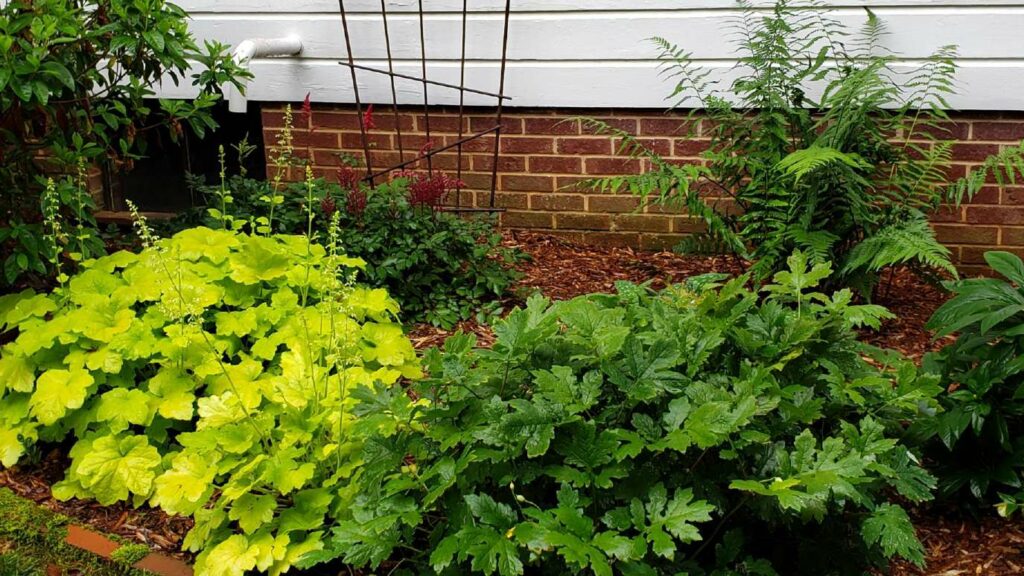
Pro Tip #2: After Your Assessment, Research Common Traits and Needs of Plants and Then Make Your Garden Purchases
- Select plants whose needs can be met by the conditions in your garden.
Select plants that are most likely to thrive in your shade garden based on your assessment. Nursery tags generally identify the conditions under which a plant will grow. Fortunately, the North Carolina Extension Gardener Plant Toolbox provides a much more comprehensive, yet easily searchable, online research tool for finding the right plants for your shade garden. After you plant, signs that a plant may not be in the “right place” include leaning in search of sunlight, foliage burned by the sunlight, or droopy stems, flowers, or leaves. If you got it wrong, try a different spot, adjust your watering regime or make other maintenance changes.
- Bring color and texture into your shade garden.
The shade gardener does not focus solely on blooms, but looks to foliage, artwork, sculpture, “whimsy” and containers for color and variety. Shade gardeners “paint” their garden compositions with foliage — in shades of green, yellow-green and burgundy. They rely on leaf variegation, stem or trunk colors, and texture and form of leaves to provide garden interest that lasts longer than any bloom. You may call it making a virtue of necessity. However, it’s undeniable that variable foliage textures placed in close proximity and repeated throughout a garden composition provide a sense of unity and beauty, no matter the flower contribution — as the Harris’s sublime garden so wonderfully demonstrates.
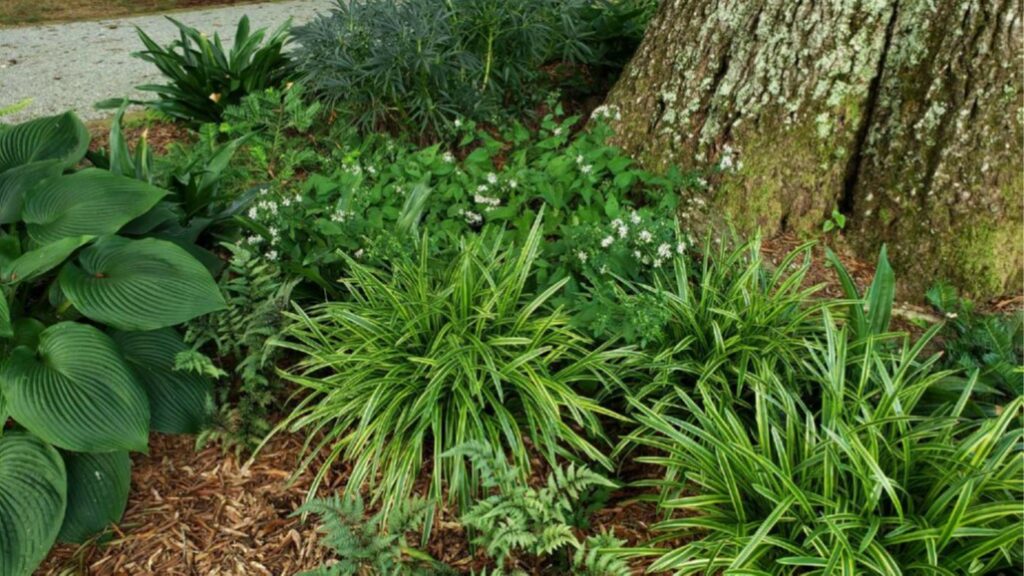
COMMON SHADE PLANTS
Moist Conditions
- Cyclame
- Trillium
- Solomon’s Seal
- Hostas
- Ferns
- Astilbe
- Heuchera
- Sweet Woodruff
- Columbine
- Pulmonaria
- Hydranga
- Azaleas
- Bell Flower
- Cardinal Flower
- Acuba
- Boxwoods
- Goat’s Beard
- Virginia Blue Bells
Drier Conditions
- Ajuga
- Dianthus
- Mondo grass
- Hellibore
- Phlox
- Pachasandra
- Anemome
- Pulmonaria
- Acuba
- Cardinal Flower
- Azaleas
- Boxwood
- Goat’s Beard
- Day Lilly
- Primrose
LESS COMMON (BUT INTERESTING) PART SHADE PLANTS
- Daphne
- Helesia
- Acantha
- Red or Yellow Twig Dogwood
- Fothergilla
- Nine Bark
- Dystillium
- Box Honeysuckle
- Edgeworthia
- Winterberry
This article is based on the Orange County Master Gardener Volunteers March 18, 2023, Dig Deeper – “Shade Gardening” presentation and plant list, by Frances and Bill Harris. All photos are by Frances and Bill Harris.
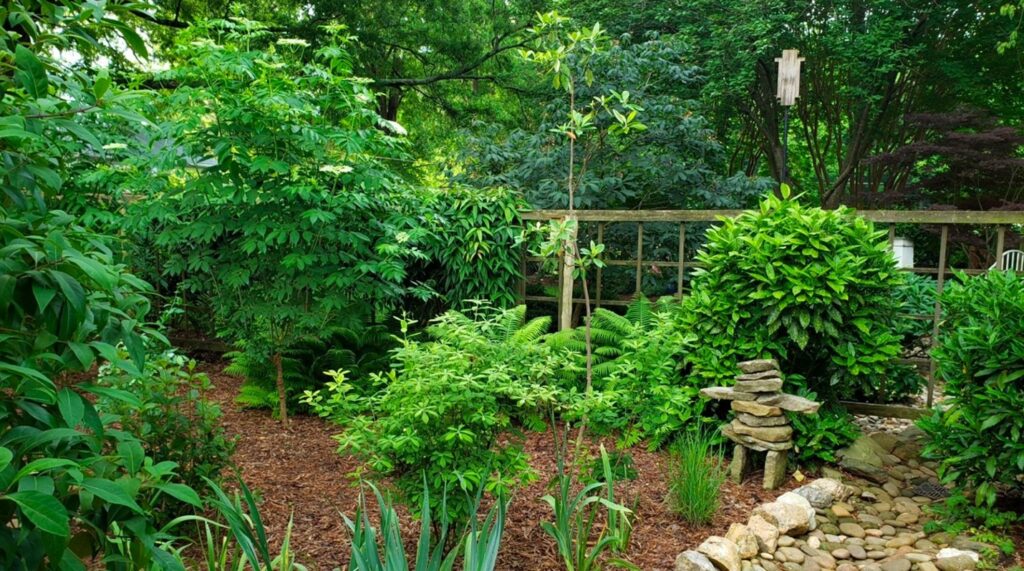
Has this article piqued your interest so that you want to know more? Please check out these other resources:
- Shade Gardening, Lee County Extension.
- SHADE GARDENING The Extension Demonstration Garden Information Booklet, NCSU and NC A&T Cooperative Extension (includes lists of plants for all purposes that do well in moist and dry shady conditions).
- Native Plants for Shade, University of Maryland Extension.
- Defining Sun Requirements for Plants, K-State Research and Extension, Johnson County.
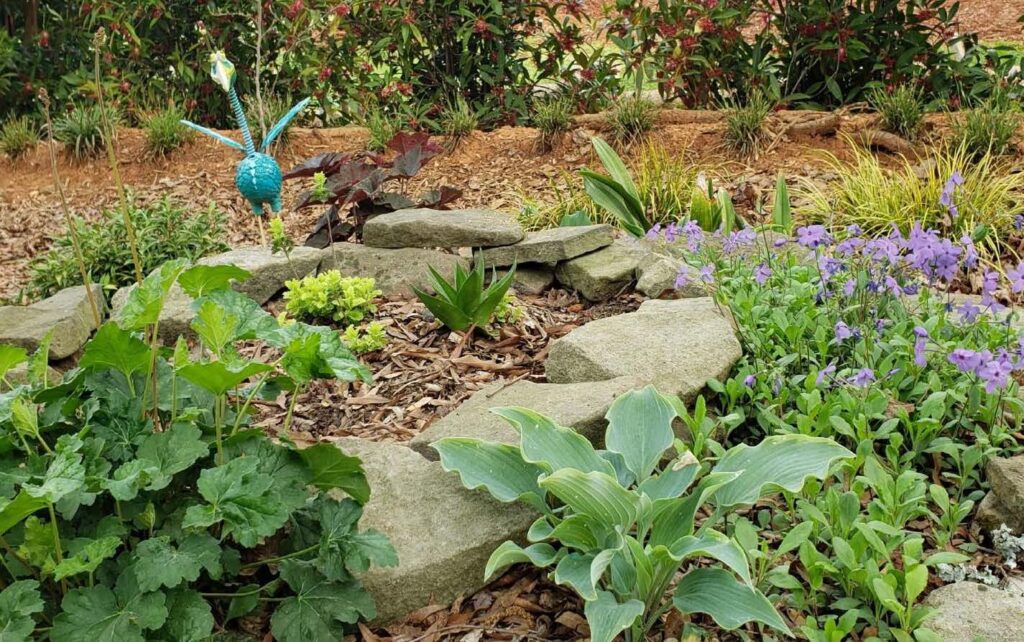
Check Us Out!
- Have a plant or garden question? Email the Orange County Master Gardener volunteers at ocmgardeners@gmail.com or phone 919-245-2061.
- Follow us on Facebook! Our page is Orange County NC Extension Master Gardener Volunteer.
- Subscribe to The Garden Buzz, the Orange County Master Gardeners’ monthly newsletter, for gardening news and tips. And visit our website, The Orange Gardener.
- Save the date! The Orange County Master Gardener volunteers will hold PlantFest, a plant sale and festival, on Oct. 14, 2023, 9 a.m. to 2 p.m., at 1020 US 70 W, Hillsborough, NC 27278.
Chapelboro.com does not charge subscription fees, and you can directly support our efforts in local journalism here. Want more of what you see on Chapelboro? Let us bring free local news and community information to you by signing up for our biweekly newsletter.




